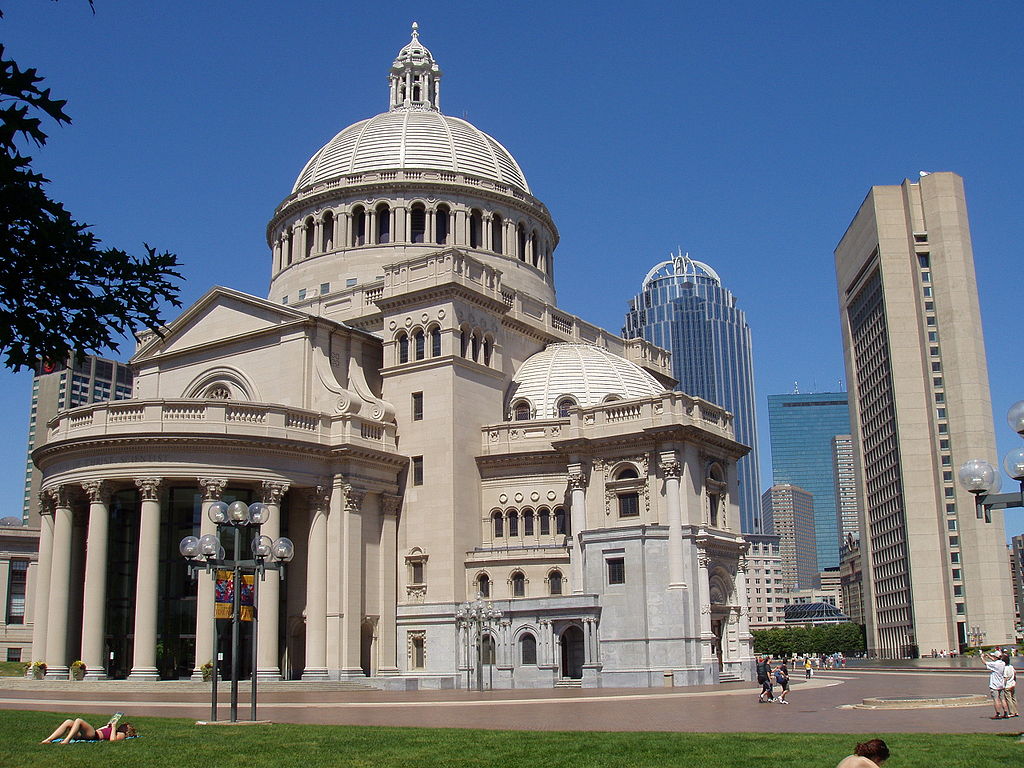A prominent but secretive religious sect founded in the nineteenth century, Christian Science has often been at the center of conspiratorial speculation. In the period after the Civil War the United States was a breeding ground for new religious movements.
Of these, Christian Science (formally known as The Church of Christ, Scientist) was one of the most successful. Since the 1960s the church has become influential in the United States and beyond through the publication of its newspaper, the Christian Science Monitor, and through some of its members being in positions of power (e.g., Nixon aides H. R. Haldeman and John Ehrlichman).
After the failed attempt to establish a cable television channel in the 1980s, the church was beset by financial difficulties and scandals in the 1990s, including reports that it had borrowed from its own pension fund.
  |
Known for the belief that only the mind and spirit exist in reality, and that pain, disease, and even death are illusions, Christian Scientists practice religious healing in place of medical intervention, a policy that recently has been the subject of much controversy after the deaths of several children whose parents allegedly followed these tenets.
The sect was founded in the late nineteenth century by Mary Baker Eddy (1821–1910) after she experienced a spontaneous healing. Eddy had suffered from frequent mental and physical disorders throughout her first four decades. After undergoing treatment by Phineas Parkhurst Quimby, a mesmerist and faith healer, Eddy began to find relief from her ailments. After Quimby’s death, in 1866, Eddy emerged as a teacher and healer.
Eddy’s early attempts to gather a following were fraught with disappointment, but despite setbacks, the determined Eddy pushed on. In 1875 she published Science and Health and followed it with The Key to the Scriptures in 1883.
These provided the base for the new religion. From 1881 to 1889, new practitioners were trained at the Massachusetts Metaphysical College. These disciples then returned home to heal the sick and spread the new religion.
 |
| The Mother Church in Boston, Massachusetts. |
In 1892, she established The Mother Church to coordinate and centralize authority in her far-flung sect. The result of Eddy’s reorganization coupled with a trained and loyal cadre of followers fanning out across the nation led to an exponential growth of Christian Science in the late nineteenth century.
As the cult prospered, suspicions about it began to multiply. Clergy and laymen began to attack the sect in general and Eddy in particular. Mark Twain was among the more famous critics of the new denomination. The seemingly sudden explosion of Christian Science led Twain to worry that by sheer force of numbers it would control the U.S. Congress by the 1930s.
Churchmen saw not only a danger of losing members (many lost congregants in mass exoduses) but the undermining of modern civilization by such a mystical and pantheistic religion. Detractors believed that the Christian Science denial of the existence of sin and the body would destroy the moral fabric of society by undercutting all morality. Many suspected that Eddy’s use of the Bible was just a cover to hide the diabolic nature of her teachings.
   |
Adding to the critics’ concerns was the sect’s penchant for secrecy. No one outside the ruling elite even knew how many members belonged to the denomination. The church’s bylaws prohibited the release of membership numbers outside the organization. Financial matters were a closely guarded secret. Even today, official records of the church are largely off limits to nonmember researchers.
Many suspicions about Christian Science centered on the habits of its controversial founder. During her lifetime Eddy refused to relinquish any power over the governance of the sect. All high officials were responsible to her alone.
Only her writings (which many felt had been either plagiarized from Quimby or ghostwritten by her disciples), along with select passages from the Bible, were to be used in worship. Eddy’s authoritarianism and her statements led critics to charge that she actually saw herself as equal with (if not above) Jesus and, in effect, a deity. Even if this was not her intention, opponents felt that Eddy’s deification would eventually be the result of her teachings.
For a potential deity and a believer in the nonexistence of anything except the mind, Eddy appeared very materialistic to her critics. She was obsessive about copyrighting virtually every communiqué she wrote and amassed a fortune of over two million dollars—though during her lifetime it was suspected of being much higher. Eddy and her church were accused of being charlatans and hucksters—bilking the ignorant and weak out of their money for a cure that could not be had without the Christian Science–trained healer.
A final concern of the opponents of Christian Science was that its mystic cures were a danger to the health of its “patients.” For obvious reasons, medical professionals were most concerned with these alleged healing practices. Individual doctors and the American Medical Association attacked the sect as a danger, especially to infants as well as to the community at large, as the inadvertent spreader of communicative diseases through its hostility to vaccinations.
Opponents of Christian Science need not have worried. Although the sect has survived to the present day, it has not posed the danger to society that critics predicted. Its estimated worldwide membership is 150,000 scattered among 2,600 branch churches. Most nonmembers’ only knowledge of the sect is in the form of the newspaper it publishes, the Christian Science Monitor, and the “Reading Rooms” placed in conspicuous locations by the branch churches—reminders of a more vibrant and “dangerous” Christian Science.
